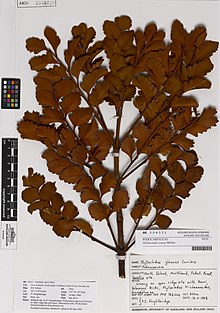|
Phyllocladus toatoa
Phyllocladus toatoa, known as toatoa (Māori) or blue celery pine[2] is a species of conifer in the family Podocarpaceae, endemic to New Zealand. It was formerly referred to as P. glaucus.[3] Botanical descriptionPhyllocladus toatoa is a small, dioecious or monoecious, conical or bushy tree that grows to 15 m (49 ft) in height and 60 cm (24 in) in diameter at maturity on average.[2] The outer bark ranges in color from dark brown to a silvery-brown.[3] P. toatoa is distinguishable from other species in the genus Phyllocladus due to its whorled pinnate phylloclades with diamond-shaped segments.[2] Attached to whorled branches are cladodes.[4] P. toatoa flowers between October and December, leading to a fruiting stage between January and March.[5] The fruit is a nut sitting in a cup shaped envelope.[4] Each fruit contains 3-4 3 mm square shaped seeds which are black at maturity.[3] Cultivated mature plants flower annually.[3] The species is wind pollinated by male cones which produce large quantities of pollen.[3] Seeds are black.[6] Mature seeds are dispersed from the cone through swelling of the cone bracts ejecting the seeds to the ground.[3] Distribution is limited, resulting in many seeds landing on the ground under the female tree.[3] Establishment of the species over a large area indicates that P. toatoa is dispersed by wind and birds.[3] P. toatoa is difficult to propagate and is relatively slow growing.[7] DistributionThis species is endemic to New Zealand and is found in the North Island.[6] Range and habitatPhyllocladus toatoa can be found in lowlands and montane forests including the central North Island and northwards.[3] It is considered to be well protected and not considered threatened.[3] Due to its tolerance of infertile soils, it can be found on exposed ridges, around bog margins, and other poorly drained land in New Zealand.[8] The preferred habitat is that of a temperate climate with well-drained, moist soil, where roots are partially shaded and foliage is exposed to sun.[5] ReferencesWikimedia Commons has media related to Phyllocladus toatoa.
|
||||||||||||||||||||||||||||||||
Portal di Ensiklopedia Dunia

